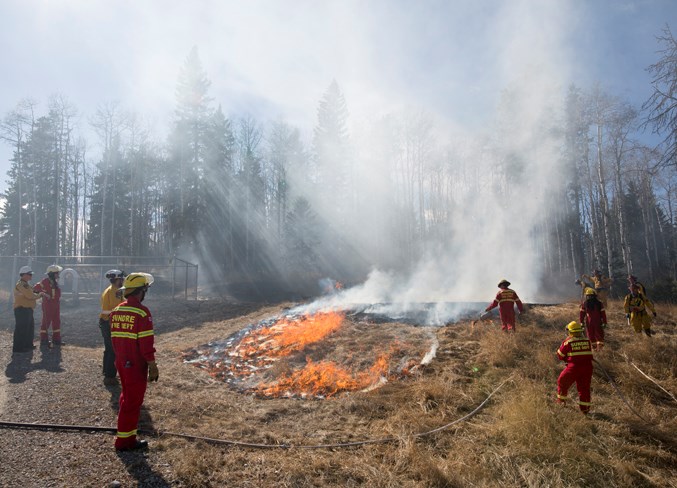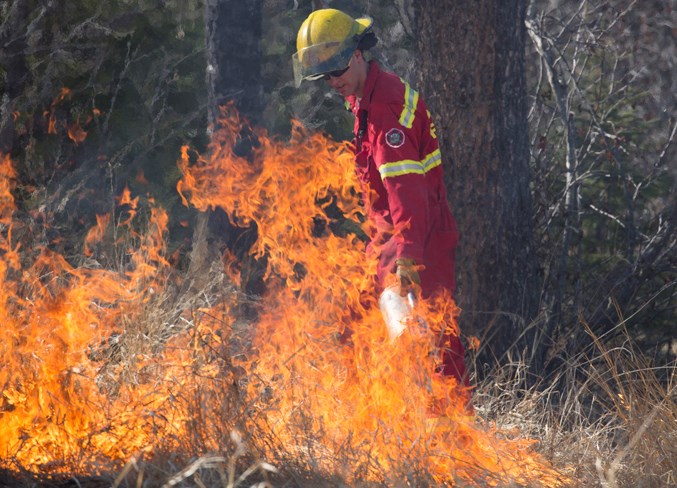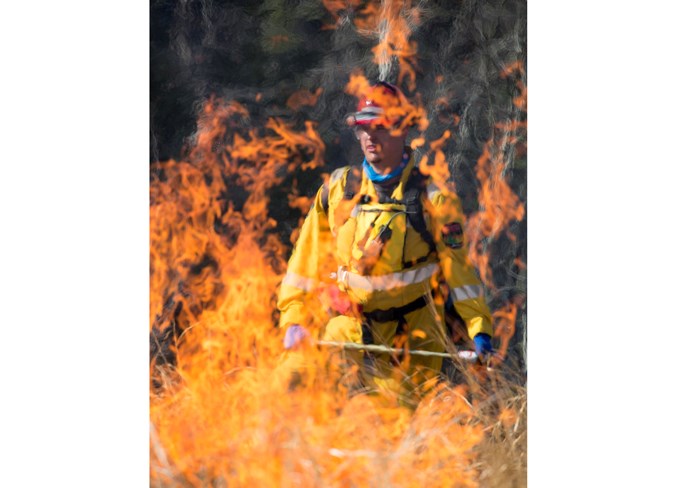Living in a wildland-urban interface requires a constant effort to remain vigilant and take proactive measures to reduce the chances of a wildfire, or at least the severity of such an event.
About 15-20 members of the Sundre Fire Department teamed up Wednesday, April 17 with an Alberta Agriculture and Forestry wildland crew of 10 firefighters from Rocky Mountain House on the first controlled burn of the season, said Marty Butts, Sundre’s fire chief.
Getting started mid-afternoon, the joint exercise was carried out on the top of Snake Hill near the municipality’s water treatment plant, said Butts.
“We tried to concentrate on the water treatment plant, as that being major infrastructure we want to protect,” he said.
Grass and other potential “fine fuels” that would feed and substantially accelerate a wildfire had been accumulating over the past number of years. The fire chief felt the time had come for a controlled burn to protect the water plant.
“It’s pretty important to us,” he said, adding in the event of a worst-case scenario, the plant’s failure would result in no water not only for fire hydrants but also for the rest of the community.
 Although windy conditions caused some concerns, the crews were able to safely finish the controlled burn near the water plant by doing smaller portions of land at a time. Noel West/MVP Staff
Although windy conditions caused some concerns, the crews were able to safely finish the controlled burn near the water plant by doing smaller portions of land at a time. Noel West/MVP Staff
Fine fuels — as opposed to heavy fuels such as logs and trees — are really quick burning and can spread quickly under the right conditions, taking off within minutes across a field and potentially threatening people’s homes, he said.
“Those are really dangerous,” he said, adding such a scenario can be ignited by as little as an improperly extinguished and discarded cigarette butt.
“It doesn’t take much to get fine fuel fires going when the conditions are right.”
Butts said last week’s controlled burn worked out very well, and also provided an important opportunity for Sundre’s firefighters to coordinate with their wildland firefighter counterparts. He expressed a commitment to keep the exercise an annual endeavour.
“It’s a great tool to cross-train with each other,” he said.
“We do work hand-in-hand quite a bit with forestry in the West Country.”
 A Sundre Fire Department member lights an area of grass during the controlled burn.
A Sundre Fire Department member lights an area of grass during the controlled burn.
Knowing one another’s radio systems and overall procedures helps to coordinate during a real emergency and ideally improve the outcome, he said.
“It’s kind of like a win-win for everybody.”
Members of the local departments conducted additional burns — including one west of the Sundre Seniors Supportive Living lodge — after their Rocky Mountain House colleagues headed out for the night, he said.
“They were only able to stay so long,” he said, adding Sundre firefighers were wrapping up by about 9:30-10 p.m.
“We were cleaning up into the dark.”
However, the fire department was unable to accomplish everything the chief had hoped to do.
“We ran out of time,” he said.
Windy conditions nearly cancelled the controlled burn in the first, Butts said, adding that for for safety’s sake firefighters tackled smaller portions of land at a time to ensure the flames would not get a chance to grow too big and spread out of control.
“We had to be more cautious,” he said.
“We did what we could with the conditions we were dealing with.”
Crews nevertheless successfully completed the controlled burn around the water treatment plant, he said.
Depending on what conditions allow in the coming weeks, the fire chief still hopes to get the local crew out to do a few more controlled burns by the end of April and early May. Provided the weather allows, Butts hopes to be out again this Wednesday, which coincides with the department’s weekly training exercises.
There is a limited window of opportunity to do controlled burns after winter and before the spring greening, he said.
“This is the perfect timeframe right now to do it for the season. We want to take that opportunity and hopefully clear up as much as we can in that timeframe,” he said, adding fire bans could be upon us “before we know it”, which would prevent any further controlled burns.
Anyone with questions or concerns about an area that would benefit from a controlled burn can contact Butts at (4030 638-6516.
“But I have a list a mile long — we can only do so much,” he said, adding areas identified as serious could be added to his already lengthy priority list without being able to guarantee when it’ll get done.
Bearing in mind the fire department is not in a position to tackle every area that would benefit from a controlled burn, Butts suggested other options for property owners, ranging from farming off overgrowth or allowing animals to graze, to mowing or otherwise manually clearing dry vegetation and grass, as well as even hiring a private company to do the controlled burn.



